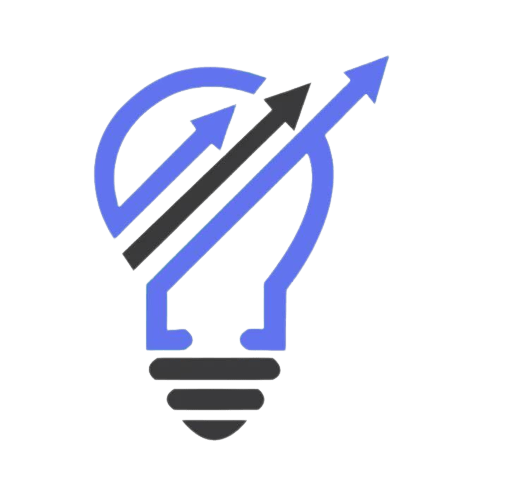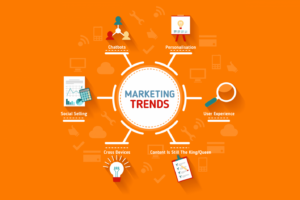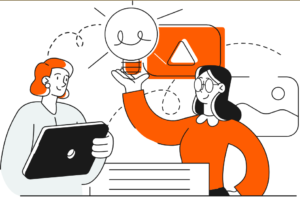A complete guide to logo designing.
A good logo can effectively communicate a brand’s perception and value, without a using single word. That’s the power of a well-designed logo.
The logo designing process differs from one graphic designer to another due to the difference in approach. However, we have created a generalized outline for a flawless logo development process to help you start. Follow the next few steps to excel in the art of crafting a unique logo.
1. Understand the organization and its audience:
This step is called, the ‘The client discovery’ step. Here, before deciding what to ‘say’ in the logo, you have to learn what problems the brand aims to solve through this logo or what impression it wants to give. Learn what the brand values and embodies. Doing so will help you find the brand voice which can be formal, friendly, eloquent, etc.
Know about your audience. Research their demographics and preferences. This way, you will know exactly which elements you have to incorporate in order to grab their attention!
Some principles of unique logos that you should know before designing one are:
- The design must be simple and readable. Too many effects or graphics will overcrowd it and make it confusing
- A great logo has to be timeless. Which means, it will stand great even after a decade or two.
- Make a memorable logo. Something that is easily recognizable.
- Most importantly, the logo should be versatile. It should be scalable with intact quality.
Now, after the initial step let’s proceed to the next one.
2. Researching and studying:
Once you’re done noting and understanding your client and the background of the brand, now it’s time to learn about the industry or niche of their brand. This is the ‘industry discovery’ phase.
In this phase, you have to study the logos of the competitors. Things you can look for are:
The overused techniques: These techniques will be the ones that will be familiar to almost all brands of a particular industry. Such brands are mostly following one of the competitors for whom this technique turned out well. But, since everyone has made that technique mainstream, it lost its value.
Ignored techniques: On the contrary, these might be the techniques that you actually want to look into and consider using while designing your logo. These again will be the ones found in the leading rival’s logo. Just small details that help them stand apart.
Take notes of all such details, then you can choose to go trendy or distinctive. You can also do a little research on how the psychological effects can impact your logo. This way, you will be able to make a wise selection of colors and shapes. Adding the right details can really alter the motivation to take an action.
3. Know where the logo will be used:
Knowing whether your logo will be used on a huge billboard or occupy a tiny space on the mobile app, will help you determine how many details you should add. For a larger canvas, you can more details and opt for larger scales. However, for the latter, you may go for something more simple and less scaled to avoid recognizability trouble. A responsive logo is increasingly popular these days which takes away the hurdles of creating different logos for different sizes of screens.
4.Brainstorm and sketch it out
Now that you have all the inspiration and information needed, it’s time to strategize the right logo design. You can start by searching for the visual representation of the important keywords. It will give an idea of the graphs that are essential to communicate it. Search for them on popular sites such as Pinterest, Dribble, or Behance. Next, you can look for what color or font goes with your brand’s message.
Before jumping on the logo design software, get creative. Sketch out different ideas using your computer, or even a sketchbook! This will give you all the creative freedom to explore what goes best with your logo. You will see what sits well and what changes you have to make. Mix and match till you find a perfect one.
5. Start drafting digitally in vector software:
Now that you have a rough idea of how you want your logo to be, start executing it digitally. Take the top three of your sketches and recreate them. Adobe Illustrator can be used for the purpose of creating vector designs. Experiment with logo colors and typography. Find what’s suitable for your logo and go ahead with it.
6. Get feedback on the logo you just designed:
Show the newly crafted logo to a variety of people. Be open to criticism. Sometimes we are so absorbed in the hard work of delivering the best that we tend to oversee minor details. However, an eye of an ordinary man is not as ordinary as you may think. It can give you a fresh perspective and will help you unravel all the small imperfections or overseen mistakes. Correcting them will help you improve before finalizing. Gather fresh ideas and put them to good use. It’s an easy key to a flawless logo design.
7. Deliver the final logo:
Now, whether you were designing a logo for a client or for yourself, it’s time to finalize it. After doing so, you can include the following before sending it to your client:
- Layered EPS/PDF files
- High-resolution raster files and PNGs with a transparent bg.
- Layered source vector files.
- Variations of logos (monochromatic and colored)
And voila! You are done making a logo that will stand out and carry all the meanings, efficiently.
Lastly,
If you wish to learn more about it or get a logo designed for yourself at a discounted price, contact us at https://strategyinn.com/
Click now to avail the discount, just for you!









